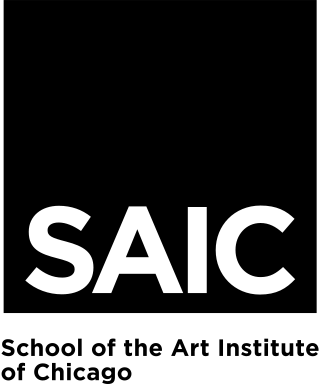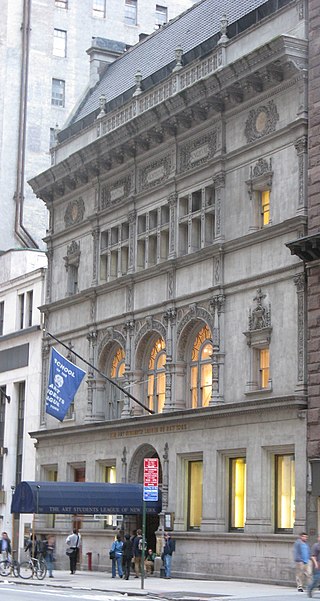
The School of the Art Institute of Chicago (SAIC) is a private art school associated with the Art Institute of Chicago (AIC) in Chicago, Illinois. Tracing its history to an art students' cooperative founded in 1866, which grew into the museum and school, SAIC has been accredited since 1936 by the Higher Learning Commission, by the National Association of Schools of Art and Design since 1944, and by the Association of Independent Colleges of Art and Design (AICAD) since the associations founding in 1991. Additionally it is accredited by the National Architectural Accrediting Board. In a 2002 survey conducted by Columbia University's National Arts Journalism Program, SAIC was named the “most influential art school” in the United States.

Contemporary art is the art of today, produced in the second half of the 20th century or in the 21st century. Contemporary artists work in a globally influenced, culturally diverse, and technologically advancing world. Their art is a dynamic combination of materials, methods, concepts, and subjects that continue the challenging of boundaries that was already well underway in the 20th century. Diverse and eclectic, contemporary art as a whole is distinguished by the very lack of a uniform, organising principle, ideology, or "-ism". Contemporary art is part of a cultural dialogue that concerns larger contextual frameworks such as personal and cultural identity, family, community, and nationality.

Folk art covers all forms of visual art made in the context of folk culture. Definitions vary, but generally the objects have practical utility of some kind, rather than being exclusively decorative. The makers of folk art are typically trained within a popular tradition, rather than in the fine art tradition of the culture. There is often overlap, or contested ground with 'naive art'. "Folk art" is not used in regard to traditional societies where ethnographic art continue to be made.

Parks in Chicago include open spaces and facilities, developed and managed by the Chicago Park District. The City of Chicago devotes 8.5% of its total land acreage to parkland, which ranked it 13th among high-density population cities in the United States in 2012. Since the 1830s, the official motto of Chicago has been Urbs in horto, Latin for "City in a garden" for its commitment to parkland. In addition to serving residents, a number of these parks also double as tourist destinations, most notably Lincoln Park, Chicago's largest park, visited by over 20 million people each year, is one of the most visited parks in the United States. Notable architects, artists and landscape architects have contributed to the 570 parks, including Daniel Burnham, Frederick Law Olmsted, Jens Jensen, Dwight Perkins, Frank Gehry, and Lorado Taft.

An artist-run space or artist-run centre (Canada) is a gallery or other facility operated or directed by artists, frequently circumventing the structures of public art centers, museums, or commercial galleries and allowing for a more experimental program. An artist-run initiative (ARI) is any project run by artists, including sound or visual artists, to present their and others' projects. They might approximate a traditional art gallery space in appearance or function, or they may take a markedly different approach, limited only by the artist's understanding of the term. "Artist-run initiatives" is an umbrella name for many types of artist-generated activity.
John Carter Brown III was the director of the U.S. National Gallery of Art from 1969 to 1992 and a leading figure in American intellectual life. Under Brown's direction, the National Gallery became one of the leading art museums in the United States, if not the world. He was known as a champion of the arts and public access to art at a time of decreased public spending on the humanities.

The Renaissance Society, founded in 1915, is a leading independent contemporary art museum located on the campus of the University of Chicago, with a focus on the commissioning and production of new works by international artists. The kunsthalle-style institution typically presents four exhibitions each year, along with concerts, performances, screenings, readings, and lectures—all of which are free and open to the public. "The Ren" also produces publications in conjunction with many of its exhibitions.

The Art Institute of Chicago, founded in 1879, is one of the oldest and largest art museums in the world. It is based in the Art Institute of Chicago Building in Chicago's Grant Park.

Arts Club of Chicago is a private club and public exhibition space located in the Near North Side community area of Chicago, a block east of the Magnificent Mile, that exhibits international contemporary art. It was founded in 1916, inspired by the success of the Art Institute of Chicago's handling of the Armory Show. Its founding was viewed as a statement that art had become an important component of civilized urban life. The Arts Club is said to have been pro-Modernist from its founding. The Club strove to break new ground with its shows, rather than collect the works of established artists as the Art Institute does.
Visual arts of Chicago refers to paintings, prints, illustrations, textile art, sculpture, ceramics and other visual artworks produced in Chicago or by people with a connection to Chicago. Since World War II, Chicago visual art has had a strong individualistic streak, little influenced by outside fashions. "One of the unique characteristics of Chicago," said Pennsylvania Academy of Fine Arts curator Bob Cozzolino, "is there's always been a very pronounced effort to not be derivative, to not follow the status quo." The Chicago art world has been described as having "a stubborn sense ... of tolerant pluralism." However, Chicago's art scene is "critically neglected." Critic Andrew Patner has said, "Chicago's commitment to figurative painting, dating back to the post-War period, has often put it at odds with New York critics and dealers." It is argued that Chicago art is rarely found in Chicago museums; some of the most remarkable Chicago artworks are found in other cities.
Tony Tasset is an American multimedia artist. His works consists mainly of video, bronze, wax, sculpture, photography, film, and taxidermy. He has had exhibitions in Dallas, Chicago, Milwaukee, New York, Los Angeles, Germany, Canada, Portugal, Italy, Ecuador, and London.

The Art Students League of New York Building is a building on 57th Street in Midtown Manhattan in New York City. The structure, designed by Henry Janeway Hardenbergh in the French Renaissance style, was completed in December 1892 and serves as the headquarters of the Art Students League of New York. The building was developed by the American Fine Arts Society (AFAS), formed in 1889 by five organizations including the Art Students League, the Society of American Artists, and the Architectural League of New York.

The Hoosier Salon is an annual juried art exhibition that features the work of Indiana artists and provides them with an outlet to market their work. The Hoosier Salon Patron's Association, the nonprofit arts organization that organizes the event, also operates a year-round galleries in New Harmony, Indiana and at one time in Wabash and Carmel, Indiana. These spaces host exhibitions of Salon artists throughout the year, as well as workshops and demonstrations. An artist must have lived in Indiana and must be a member of the Hoosier Salon arts organization to become eligible for the Salon's exhibitions. The Hoosier Salon has exhibited art from many of Indiana's most notable painters, sculptors, cartoonists, and mixed-media artists, including Hoosier Group artists, several members of the Brown County Art Colony, and other artists with ties to Indiana.

Enella Benedict was an American realism and landscape painter. She taught at the School of the Art Institute of Chicago and was a founder and director for nearly 50 years for the Art School at the Hull House.
Women's Art Resources of Minnesota (WARM) is a women's art organization based in the U.S. state of Minnesota. It was founded in 1976 as Women's Art Registry of Minnesota, a feminist artist collective. The organization ran the influential WARM Gallery in downtown Minneapolis from 1976 to 1991.
Beatrice Sophia Steinfeld Levy was an American printmaker and painter, draftsman, and instructor.

The Graham Foundation for Advanced Studies in the Fine Arts is a 501(c)3 non-profit that “fosters the development and exchange of diverse and challenging ideas about architecture and its role in the arts, culture, and society. The Graham realizes this vision through making project-based grants to individuals and organizations and producing exhibitions, events, and publications.”

An art gallery is a room or a building in which visual art is displayed. In Western cultures from the mid-15th century, a gallery was any long, narrow covered passage along a wall, first used in the sense of a place for art in the 1590s. The long gallery in Elizabethan and Jacobean houses served many purposes including the display of art. Historically, art is displayed as evidence of status and wealth, and for religious art as objects of ritual or the depiction of narratives. The first galleries were in the palaces of the aristocracy, or in churches. As art collections grew, buildings became dedicated to art, becoming the first art museums.

Merry Renk, also known as Merry Renk-Curtis, was an American jewelry designer, metalsmith, sculptor and painter. In 1951, she helped to found the Metal Arts Guild (MAG), and served as its president in 1954.













